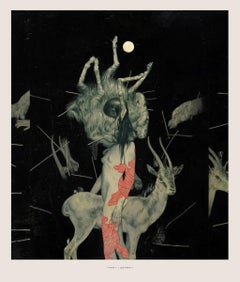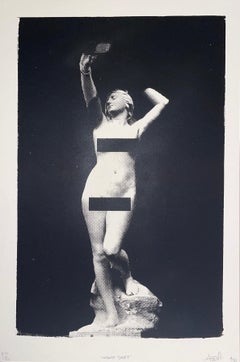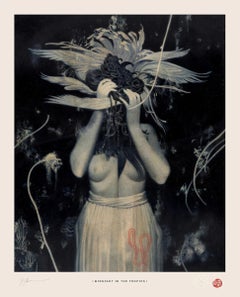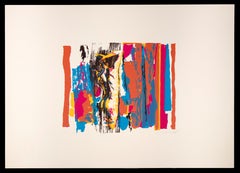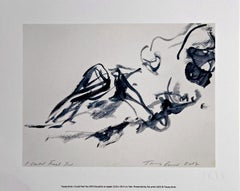New Union Gallery Nude Prints
to
1
2
Overall Width
to
Overall Height
to
1
2
3
3
1
1
1
1
1
1
2
2
1
3
Hunt Gather Signed and Numbered Print Macabre Illustration
By Joao Ruas
Located in Draper, UT
For sale is an exceptional fine art print titled "Hunt Gather" by the talented Brazilian artist João Ruas. This beautiful giclée print is printed on 350 gsm 100% Cotton Hahnemühle Mu...
Category
2010s Abstract Prints
Materials
Black and White, Archival Pigment
IHeart "Night Shift" Screenprint Glow In The Dark Ink's Street Contemporary Art
Located in Draper, UT
Title:
IHeart Screenprint "The Night Shift" Glow In The Dark Inks Contemporary Street Art
Year:
2018
Classification
Limited edition
Medium Type
Print
Medium/Materials
Hand Pulled Screen Print On 100# (260/m2) French Cover Stock
Categories
Silkscreen / Graffiti and Street Art / Pop and Contemporary Pop / Nude / Feminist Art and Contemporary Feminist
Provenance
Comes With C.O.A. From The Artist.
Additional Info
Print Glows in the Dark with Special UV Inks.
Signature
Signed & Numbered In Pencil By The Artist, I Heart Stencil...
Category
2010s Street Art Nude Prints
Materials
Screen
Midnight in the Tropics Signed and Numbered Print Macabre Illustration
By Joao Ruas
Located in Draper, UT
For sale is an exceptional fine art print titled "Midnight in the Tropics" by the talented Brazilian artist João Ruas. This beautiful giclée print is printed on 350 gsm 100% Cotton H...
Category
2010s Abstract Prints
Materials
Black and White, Archival Pigment
Related Items
The Shower - Original Screen Print by Nicola Simbari - 1976
By Nicola Simbari
Located in Roma, IT
Hand Signed. Edition of 90 pieces.
Very good conditions.
Category
1970s Contemporary Figurative Prints
Materials
Screen
$471
H 19.69 in W 27.56 in D 0.04 in
I Could Feel You, Tracey Emin, rare 2015 giclee print plate signed 300 gsm paper
By Tracey Emin
Located in New York, NY
Tracey Emin
I Could Feel You, 2015
Archival quality giclée print on Purcell Ultrasmooth Fine Art Paper 300 GSM
9 1/2 × 12 inches
Plate signed
Unframed
Rare archival quality, giclée reproduction of Tracey Emin's original gouache I Could Feel You, which is in the permanent modern art collection of the Tate. This was printed back in 2015 in an undisclosed limited edition, and is now long sold out.
More details about the original 2014 work are on the Tate Gallery's website as follows:
Emin, whose work is often candidly autobiographical, scrutinises her relationship with her own body, using drawing...
Category
2010s Contemporary Abstract Prints
Materials
Giclée
"Seated Nude Woman, 1916-1917" Silkscreen Print. Printed In Italy.
By Amedeo Modigliani
Located in Chesterfield, MI
Published By Top Art Milano, 1999.
Silkscreen Print.
Printed In Italy.
In Good Condition.
Measures 27.5 x 19.75 in.
Category
20th Century Nude Prints
Materials
Screen
$120 Sale Price
20% Off
H 27.5 in W 19.75 in
Helen Nude /// Tom Wesselmann Screenprint Nude Pop Art Flowers Interior Room
By Tom Wesselmann
Located in Saint Augustine, FL
Artist: Tom Wesselmann (American, 1931-2004)
Title: "Helen Nude"
*Signed, dated, and numbered by Wesselmann in pencil lower right
Year: 1981
Medium: Original Screenprint on heavy unb...
Category
1980s Pop Art Nude Prints
Materials
Screen
$20,000
H 42.63 in W 43.13 in
Shiny Nude (Stealingworth, 33) silkscreen on kromekote paper + envelope 917/1000
By Tom Wesselmann
Located in New York, NY
Tom Wesselmann
Shiny Nude (Stealingworth, 33), 1977
Silkscreen on glossy cast-coated Kromekote paper
8 × 8 inches
Edition of 1000 (917/1000)
Pencil numbered...
Category
1970s Pop Art Nude Prints
Materials
Screen, Paper
Keith Haring Crack Down! (Keith Haring 1986)
By Keith Haring
Located in NEW YORK, NY
Keith Haring Crack Down! 1986:
Vintage original Keith Haring anti-drug poster, 1986.
Off-set lithograph on heavy weight paper.
Dimensions: 17 x 22 inches.
Minor signs of handling; ...
Category
1980s Street Art Figurative Prints
Materials
Lithograph, Offset
Keith Haring Public Illumination 1981
By Keith Haring
Located in NEW YORK, NY
Keith Haring Public Illumination 1981:
A rare, highly collectible small pamphlet-style art magazine (measuring 4.25 x 2.75 inches), featuring a centerfold spread illustrated by Keith Haring, playfully credited under the moniker "Kip Herring."
The illustrations include some of Haring's signature early motifs including dogs, crawling babies, and figures in varying sexual positions.
A rare, early Haring collectible which quite possibly marks his first appearance in a printed publication.
Staple bound zine (art magazine), 4.25 x 2.75 inches.
Good to very good overall vintage condition; appears unused.
Unsigned from an edition of unknown.
Literature/References:
Printed Matter Inc., New York, NY
Public Illumination Magazine:
Founded by Zagreus Bowery in 1979 in New York and distinguished by its pocket-sized format, the publication rose to prominence in the underground art scene and was revered for its blatant mockery of mainstream magazines. The texts and drawings ranging from parody to absurdities. Contributions will be published exclusively under pseudonyms. By 2007, 51 issues appeared. The magazine is published irregularly and is available in the USA, Italy and Germany.
Writers and artists who have contributed include: Keith Haring, Ken Brown, Steve Dalachinsky, Michael Madore, David Sandlin...
Category
1980s Street Art Animal Prints
Materials
Paper, Lithograph, Offset
Tea at 5pm (Mondrian and Wesselmann), Pop Art Screenprint by Mel Ramos
By Mel Ramos
Located in Long Island City, NY
Artist: Mel Ramos, American (1935 - )
Title: Tea at 5pm (Mondrian and Wesselmann)
Year: 2008
Medium: Enamel on Steel, signed and numbered in marker
Edition: 125, 25 AP
Size: 23.5 x...
Category
21st Century and Contemporary Pop Art Nude Prints
Materials
Enamel, Cut Steel
$9,000
H 23.5 in W 27.5 in D 1.5 in
The Lovers
By Peter Max
Located in Berlin, MD
Peter Max (German / American 1937 - Present) The Lovers. Abstract of two nude women on a bed in vibrant colors. The print is on thick woven paper and is...
Category
Late 20th Century Pop Art Nude Prints
Materials
Lithograph
De l'Origine des Espèces par Voie de Sélection Irrationelle: Buste de femme
By Man Ray
Located in New York, NY
A very good impression of this color lithograph. Signed and numbered 51/180 in pencil. Printed by Mourlot, Paris. Published by Leon Amiel, New York, and XXe Siècle, Paris. From the s...
Category
1970s Modern Abstract Prints
Materials
Color, Lithograph
$2,500
H 16.25 in W 12.75 in
Standing Woman, Modern Nude Etching by Andre Minaux
By Andre Minaux
Located in Long Island City, NY
Standing Woman
Andre Minaux, French (1923–1986)
Etching, signed and numbered in pencil
Edition of EA 8/10
Image Size: 17.5 x 15.25 inches
Frame Size: 29.7...
Category
1970s Modern Nude Prints
Materials
Etching
Centaurs signed #2/20 Paula Craioveanu Photograph 20x16in in mat 28x20in
By Paula Craioveanu
Located in Forest Hills, NY
UNDER THE SKIN 5
Surreal Nude, part of my "Under the Skin" series.
Printed on Hahnemuhle art photo paper with white borders, size is 20x16in. In mat overall size 28x20in.
This par...
Category
2010s Surrealist Nude Prints
Materials
Photographic Paper
$300
H 20 in W 16 in D 0.1 in
